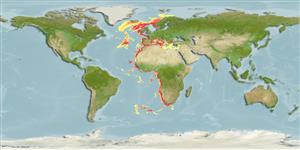Elasmobranchii (sharks and rays) >
Squaliformes (Bramble, sleeper and dogfish sharks) >
Etmopteridae (Lantern sharks)
Etymology: Etmopterus: Greek, ethmos, -ou = sieve or ethmoides bone + Greek, pteron = wing, fin (Ref. 45335).
Environment / Climate / Range
Ecology
Marine; bathydemersal; depth range 200 - 2490 m (Ref. 55744), usually 200 - 500 m. Deep-water, preferred 23°C (Ref. 107945); 75°N - 48°S, 43°W - 36°E
Eastern Atlantic: Iceland, Norway, and the western Mediterranean to Morocco, Senegal, Sierra Leone, Côte d'Ivoire to Nigeria, Cameroon to Gabon, Azores, Cape Verde, and Cape Province, South Africa.
Length at first maturity / Size / Weight / Age
Maturity: Lm ?, range 33 - 36 cm
Max length : 60.0 cm TL male/unsexed; (Ref. 247); common length : 45.0 cm TL male/unsexed; (Ref. 247); max. published weight: 850.00 g (Ref. 40637)
Found on the outer continental shelves and upper slopes. Feeds on small fishes, squids, and crustaceans. Ovoviviparous, with number of young from 6 to 20 in a litter. Utilized for fishmeal and prepared dried salted for human consumption. Depth range reported at 70m-2000m in Ref. 35388.
Distinct pairing with embrace (Ref. 205).
Compagno, L.J.V., 1984. FAO Species Catalogue. Vol. 4. Sharks of the world. An annotated and illustrated catalogue of shark species known to date. Part 1 - Hexanchiformes to Lamniformes. FAO Fish. Synop. 125(4/1):1-249. Rome, FAO. (Ref. 247)
IUCN Red List Status (Ref. 115185)
CITES (Ref. 94142)
Not Evaluated
Threat to humans
Harmless
Human uses
Fisheries: minor commercial
Tools
Special reports
Download XML
Internet sources
Estimates of some properties based on models
Phylogenetic diversity index (Ref.
82805): PD
50 = 0.5000 [Uniqueness, from 0.5 = low to 2.0 = high].
Bayesian length-weight: a=0.00295 (0.00184 - 0.00474), b=3.11 (2.97 - 3.25), in cm Total Length, based on LWR estimates for this species & (Sub)family-body (Ref.
93245).
Trophic Level (Ref.
69278): 4.1 ±0.2 se; Based on diet studies.
Resilience (Ref.
69278): Very Low, minimum population doubling time more than 14 years (Fec=6).
Vulnerability (Ref.
59153): Moderate to high vulnerability (47 of 100) .
